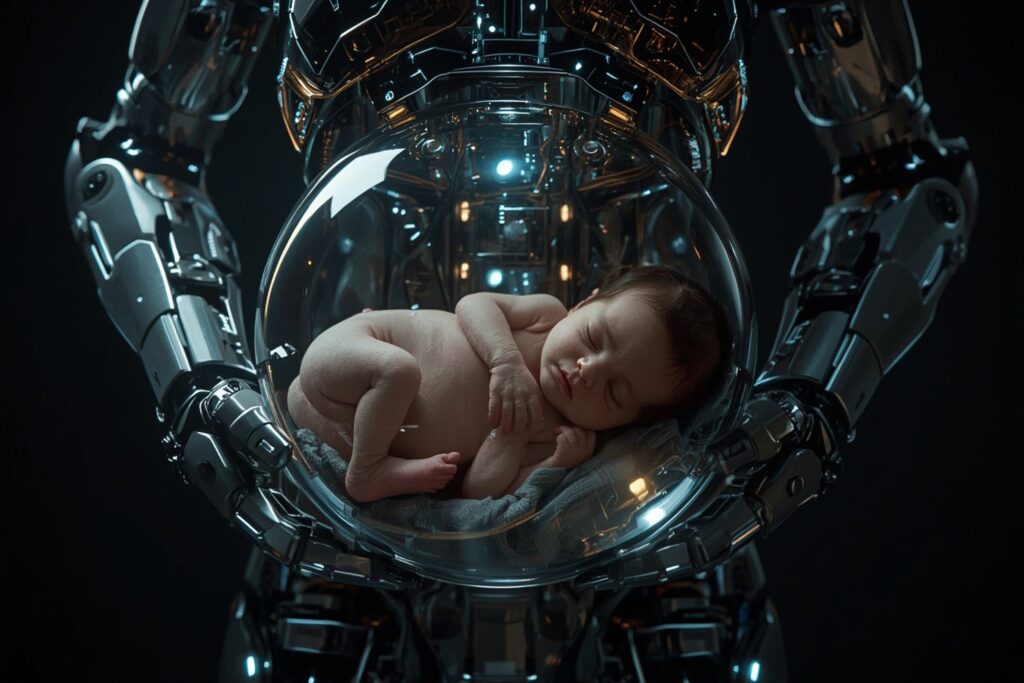
Earlier this month, news emerged about Chinese company Kaiwa Technology , which had reportedly created a “pregnancy robot.” The news was accompanied by vivid images: a life-size figure with a transparent compartment in its abdomen containing an artificial womb .
Reports claimed that the creator of the idea, a certain Zhang Qifeng, planned to unveil a prototype within a year and sell the device for less than 100,000 yuan, or about $13,900. The combination of promising timing, a relatively affordable price, and striking images ensured the news spread quickly.
The story quickly made its way to English-language publications, including the Daily Mail and Newsweek , and tech blogs and aggregators like Interesting Engineering began republishing material generated entirely by neural networks. However, when it came to fact-checking, it turned out the story was literally hanging in the air.
A Snopes investigation revealed that the images were generated by neural networks and that the person by that name was absent from both scientific databases and the alumni lists of the universities to which it was attributed . Several newsrooms rushed to remove their materials. Live Science reporters contacted Nanyang Technological University, which confirmed that there are no alumni by that name and that no research on the “robotic womb” was conducted at the institution . Two independent reviews reached the same conclusion: the stunning images were a fabrication.
This success can be explained by the fact that readers were offered a simple solution to an incredibly complex topic . The story promised a ready-made prototype, a “home appliance” price , and was accompanied by vivid images. In this context, few noticed the lack of evidence: this is exactly how emotional manipulation works in modern media .
If we raise the question and ask ourselves what is really necessary to safely deliver a baby outside the mother’s body, we discover that the problems are far greater than the technical solutions.
The first and perhaps most important obstacle is the placenta. It is not just a feeding channel, but a living system that regulates oxygen supply, balances nutrients, eliminates waste products, and provides immune protection. An engineered analogue would require a complex network of pumps, oxygenators, and microchannels that would have to function reliably for months and adapt to the growing needs of the fetus. So far, connecting animal blood vessels to external systems has only been successful for short periods, which is incomparable to the full duration of a human pregnancy .
The amniotic environment is no less important. It protects against mechanical stress, transmits signals for the proper development of the lungs and musculoskeletal system, and maintains a constant temperature and composition. Temporary “biobags” for lambs have shown that the fluid can preserve tissue for several days or weeks, but maintaining the necessary parameters for nine months without the accumulation of toxins and with the necessary mechanical stimulation is another matter entirely.
Added to this is the risk of infection. The environment inside the womb is practically sterile, but in an artificial system with tubes and sensors, every connection becomes a potential entry point for microbes. Maintaining absolute cleanliness for such a long period with constant monitoring is currently unrealistic.
The complexity is compounded by hormonal regulation . Levels of progesterone, estrogen, and other factors fluctuate throughout pregnancy, coordinating growth and preparation for labor. This isn’t a static supply of nutrients, but a dynamic feedback system. No experiment has yet succeeded in reproducing such a complex endocrine process.
Another issue is immune defense. Normally, the mother passes antibodies to the fetus, allowing the newborn to begin the first weeks of life with a ready-made defense system. An artificial implant should somehow provide similar protection.
And finally, there’s the actual birth. It’s not a simple mechanical procedure. In a short time, breathing and circulation are restored, and thermoregulation mechanisms are activated. Making this transition safe in an artificial environment is a task fraught with too many risks.
Modern research is focusing on a different goal: helping extremely premature babies. Experimental systems have made it possible to keep lambs in sterile chambers with fluids, connected to an external oxygenation system, for several days or weeks. In the United States, this is being implemented at the Children’s Hospital of Philadelphia, and similar systems are being developed in Europe. Their goal is to prolong the lives of premature babies, not replace the entire pregnancy .
This is precisely what experts are insisting on. Live Science quoted Harvey Klayman of the Yale School of Medicine, who emphasized that the idea of completely transferring the process to a machine is not only far from reality, but also raises serious ethical concerns . The responsible path is to gradually improve care for premature babies, rather than succumb to fantasies of robots with artificial wombs.
The image of a humanoid figure with a child on its lap is striking, but the image itself isn’t proof. True successes come from small but proven steps: limited timeframes, targeted tasks, and specific medical objectives. It’s these achievements, not grandiose myths, that drive medicine forward.
Follow us on Google News to receive daily updates on cybersecurity. Contact us if you would like to report news, insights or content for publication.
